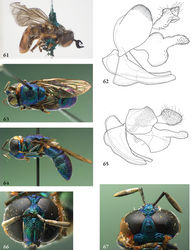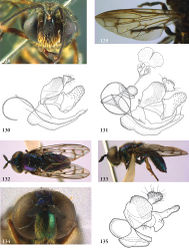Chrysidimyia
| Notice: | This page is derived from the original publication listed below, whose author(s) should always be credited. Further contributors may edit and improve the content of this page and, consequently, need to be credited as well (see page history). Any assessment of factual correctness requires a careful review of the original article as well as of subsequent contributions.
If you are uncertain whether your planned contribution is correct or not, we suggest that you use the associated discussion page instead of editing the page directly. This page should be cited as follows (rationale):
Citation formats to copy and paste
BibTeX: @article{Reemer2013ZooKeys288, RIS/ Endnote: TY - JOUR Wikipedia/ Citizendium: <ref name="Reemer2013ZooKeys288">{{Citation See also the citation download page at the journal. |
Ordo: Diptera
Familia: Syrphidae
Name
Chrysidimyia Hull – Wikispecies link – Pensoft Profile
- Chrysidimyia Hull, 1937b: 116. Type species: Chrysidimyia chrysidimima 1937: 116, by original designation. Name emended by Thompson et al. (1976)[1].
Description
Body length: 8–10 mm. Metallic green to bluish flies (legs may be yellowish), entire body densely and coarsely punctate, mimics of Chrysididae (Hymenoptera). Head about as wide as thorax. Face convexly produced in profile; about as wide as an eye. Lateral oral margins produced. Vertex flat. Occiput ventrally narrow, dorsally strongly widened. Eye densely pilose. Eyes in male with mutual distance smaller than width of antennal fossa. Antennal fossa twice as wide as high, dorsally covered by ‘shelf-like’ extension of frons. Antenna longer than distance between antennal fossa and anterior oral margin; basoflagellomere longer than scape, oval; bare. Postpronotum pilose. Notal wing lamina strongly developed; partly overlapping membranes around wing insertion. Scutellum semicircular; with calcars. Anepisternum moderately sulcate; with bare part limited to ventral half. Anepimeron entirely pilose. Katepimeron flat; bare. Katatergum carinate. Wing: vein R4+5 with posterior appendix; vein M1 perpendicular to vein R4+5; postero-apical corner of cell r4+5 widely rounded; crossvein r-m located around basal 1/4 of cell dm. Abdomen oval, about 1.5 times as long as wide. Posterior margin of tergite 1 angular. Tergites 3 and 4 fused. Male genitalia: phallus unfurcate; epandrium without ventrolateral ridge; surstylus furcate, with anterior part short and wide, posterior process long and narrow.
Diagnosis
Head, thorax and abdomen metallic green or blue. Antennal fossa twice as wide as high, dorsally covered by ‘shelf-like’ extension of frons.
Discussion
Chrysidimyia was treated as a synonym of Microdon by Thompson et al. (1976)[1], but the unfurcate phallus and the phylogenetic results of Reemer and Ståhls (in press)[2] indicate that this status cannot be maitained. Instead, the male genitalia of Chrysidimyia (Fig. 65) resemble those of Laetodon (Fig. 135); these taxa share an unfurcate phallus and a long posterior process on the surstylus. These taxa also have their metallic body colouration and pilose eyes in common. These characters may suggest a phylogenetic relationship, although this is not found by Reemer and Ståhls (in press)[2], who recovered Chrysidimyia in a large polytomy. Besides, the ‘shelf-like’ extension of the frons and dense punctuation of the body are not found in Laetodon. For this reason, we prefer to treat the groups separately.
Diversity and distribution
Described species: 1. One additional, undescribed species is known to the first author. All known records are from the Amazon region of South America, including the Guyana shield.
Taxon Treatment
- Reemer, M; Ståhls, G; 2013: Generic revision and species classification of the Microdontinae (Diptera, Syrphidae) ZooKeys, 288: 1-213. doi
Other References
- ↑ 1.0 1.1 Thompson F, Vockeroth J, Sedman Y (1976) Family Syrphidae. A catalogue of the Diptera of the Americas south of the United States 46: 1-195.
- ↑ 2.0 2.1 Reemer M, Ståhls G (in press) Phylogenetic relationships of Microdontinae (Diptera: Syrphidae) based on parsimony analyses of combined molecular and morphological characters. Systematic Entomology 38.
Images
|

